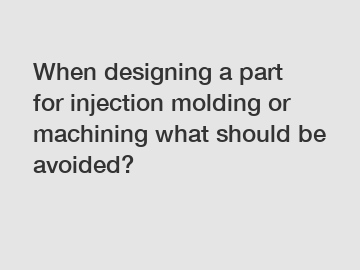Feb. 05, 2024
Rubber & Plastics
When designing a part for injection molding or machining, what should be avoided? .
Designing a part for injection molding or machining requires careful consideration to avoid potential issues and ensure successful production. Whether you're looking to create a plastic component through injection molding or a metal part through machining, there are certain pitfalls that must be avoided to achieve optimal results. In this article, we will outline the key points to keep in mind when designing for these manufacturing processes.
1. Material Selection:

Choosing the right material is crucial when designing for injection molding or machining. Different materials have varying properties and behaviors during production. For injection molding, it's important to select materials with good flow characteristics to ensure proper cavity filling and minimize the risk of defects. Conversely, machining requires materials that can withstand the cutting forces without deformation or premature tool wear. Understanding the specific requirements of each process will help you make informed decisions about material selection.
2. Wall Thickness:
Maintaining appropriate wall thickness is vital in both injection molding and machining. Thin walls can lead to numerous issues, such as warping, sink marks, or even part failure. Conversely, thick walls can cause longer cooling times, increasing production costs and potentially affecting part quality. It is crucial to strike a balance and design parts with consistent wall thicknesses to ensure uniform cooling and prevent any potential defects.
3. Undercuts and Draft Angles:
In injection molding, undercuts refer to features that prevent straight ejection of the part from the mold. Similarly, draft angles play a crucial role in both injection molding and machining. Neglecting to incorporate adequate draft angles or accounting for undercuts can result in difficulties during production, such as mold damage or problems with the release of the part. Including necessary draft angles and considering the proper ejection of undercuts will streamline the manufacturing process and ensure smoother production cycles.
4. Sharp Edges and Fillets:
Sharp edges and internal corners increase stress concentration, significantly impacting the structural integrity of a part. Both injection molding and machining are prone to issues caused by sharp edges, such as stress cracks, part failure, or decreased tool life. Incorporating fillets and radii in your design can help alleviate these problems by distributing stresses more evenly. By including appropriate fillets, you can enhance part durability while also improving the mold or tool life, leading to cost savings in the long run.
5. Overhangs and Unsupported Features:
Designing features with adequate support is crucial to prevent deformation and part failure. Overhangs and unsupported features present challenges in both injection molding and machining. In injection molding, unsupported features can lead to deformations during the cooling process, resulting in compromised part quality. Similarly, machining unsupported structures can lead to vibration, chatter, or tool deflection issues. By incorporating appropriate supports or splitting features into multiple surfaces, these challenges can be overcome.
6. Tight Tolerances:
Designing parts with overly tight tolerances can increase costs and manufacturing challenges. While precision is important, it is essential to understand the capabilities and limitations of the chosen manufacturing process. In injection molding, tight tolerances may require additional tooling steps or result in higher scrap rates. For machining, excessively tight tolerances can extend production times or lead to rejected parts. Properly defining realistic tolerances will promote successful manufacturing processes while maintaining cost-effectiveness.
7. Moldability and Machinability:
Considering the moldability or machinability of a part is critical to avoid potential production issues. Designing complex geometries or intricate features that are challenging to mold or machine increases the risk of defects, longer production times, and higher costs. It is important to consult with experienced mold makers or machinists early in the design process to evaluate feasibility and identify potential concerns. By proactively addressing moldability or machinability, you can optimize the production process and avoid unnecessary complications.
In conclusion, designing a part for injection molding or machining requires careful attention to various factors. Material selection, wall thickness, undercuts, fillets, supports, tolerances, and considering moldability or machinability are all essential steps in achieving successful part production. By avoiding common pitfalls in these areas, you can optimize the manufacturing process, reduce costs, and ensure high-quality end products. So, the next time you embark on designing a part for injection molding or machining, make sure to keep these points in mind for a smooth and efficient production journey.
For more information, please visit China Cnc Plastic Machined Parts, Oem Injection Molded Plastic Parts China, Wholesale Pp Sheet Polypropylene sheets.
Previous: Boosting Cow Comfort: Small Round Dot Rubber Mats for Hoof Health!
Next: The Ultimate Guide to HDPE Rods: Everything You Need to Know
If you are interested in sending in a Guest Blogger Submission,welcome to write for us!
All Comments ( 0 )